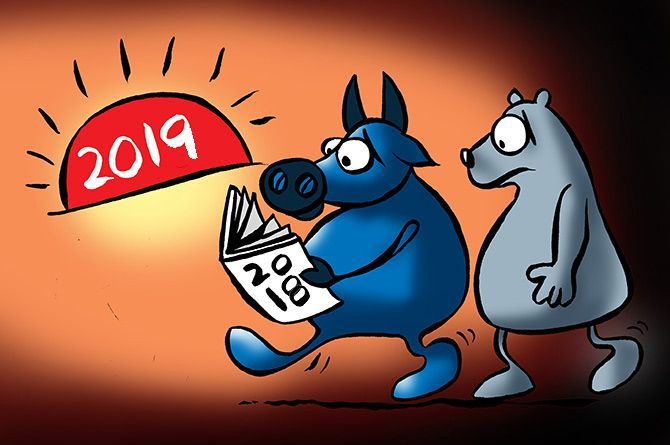The weakness in the rupee and broader markets has led to evaporation in the market cap.
Illustration: Uttam Ghosh/Rediff.com

India’s market capitalisation is down by $274 billion, or 12 per cent, in dollar terms in the past one year.
In comparison, the Sensex is down four per cent in dollar terms and has risen six per cent in local currency terms.
The weakness in the rupee and broader markets has led to evaporation in the market cap.
The rupee has depreciated by 10 per cent against the US dollar since February 2018.
The broader market-based MidCap and SmallCap indices of the BSE are down 14 per cent and 24 per cent, respectively, during the same period.
The one-year Sensex returns are positive, thanks to gains in heavyweights such as Reliance Industries (up 44 per cent in one year), Infosys (up 43 per cent) and Tata Consultancy Services (up 25 per cent).
On the other hand, Sensex companies, including Tata Motors and YES Bank, have seen their market value drop by 60 per cent.
Returns for 13 Sensex stocks are positive, while 18 are in the negative territory. The scorecard is worse for the BSE 500 index, where only one of four stocks have given positive returns since February last year.
“The benchmark indices are slightly higher but the broader market indices are down massively. We have witnessed a huge diversion in the large-cap and mid-cap performance,” said Andrew Holland, CEO, Avendus Capital Public Markets Alternate Strategies.
The introduction of long-term capital gains, goods and services tax (GST) and the IL&FS default have weighed on the performance of small- and mid-cap companies, say experts.
On the global front, the rising US dollar and bond yields have led to risk-aversion among overseas investors.
Besides, rising tensions between the US and China, two of the world’s largest economies, have weighed on the mind of investors.
Overseas investors have pulled out close to $4.5 billion from domestic stocks in the last one year.
Further, some regulatory changes, including the re-classification of mutual funds, norms for lending against shares being made stricter, and additional surveillance measures adopted by exchanges, added to the woes of mid- and small-cap stocks.
“Tightening liquidity conditions in the last one year compounded woes for smaller companies. Post the IL&FS crisis, those availing credit from NBFCs are finding it difficult to raise funds.
"That has affected the working capital cycle of quite a few companies. Unfortunately, all the negatives have coincided in a short-period leading to a rout in this space,” said Deepak Jasani, head of retail research, HDFC Securities.
India’s share in the global market cap has declined from 2.8 per cent a year ago to 2.65 per cent at present.
Siddhartha Rastogi, managing director, Ambit Asset Management, said that in 2017 mid- and small-cap stocks had run way ahead of their valuations and hence correction was inevitable.
Experts said the situation could stabilise once the election-related volatility subsides.
“In the second half of this year, you will see a reversion to the mean; there will be broad-based recovery. FPIs?(foreign portfolio investors) could come back after the political situation gets crystallised in June.
"The quarterly numbers, which came for December, were reasonably good, and I expect the numbers to be good for the quarter ending in March,” Rastogi said.











